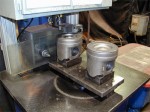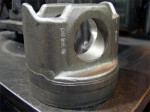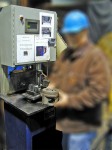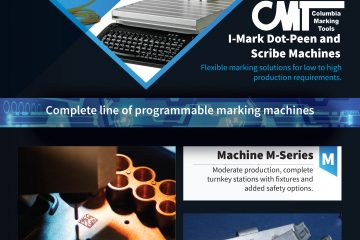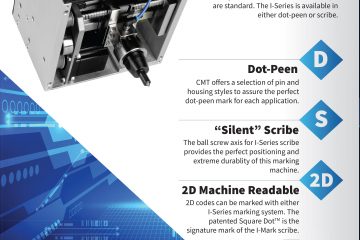Columbia dot-peen marking machine
- Fig 3
- Fig 2
- Fig
SPECIAL COLUMBIA MARKING TOOLS PM MICRO™ PEEN
MARKING MACHINE HELPS FORGING SUPPLIER PLACE
TRACEABILITY INFORMATION ON PISTON FORGINGS FOR
OFF-HIGHWAY EQUIPMENT ENGINES
Lansing, Michigan-based Customer uses special Columbia dot-peen marking machine designed to operate on-the-factory-floor in the hot forging plant.
When Customer, a leading producer of closed die hot forgings, was contracted by a leading piston manufacturer to provide large piston forgings for a new off-highway equipment engine, it was a requirement that each piston forging have specific information marked on each part. The metallurgical integrity and consistency of the forging is paramount, so the marking method preferred by the piston manufacturer was dot-peen. The dot-peen marking method imposes no perceivable stresses on the forgings, and does not create any possible arcing situations that could occur with a laser marker.
Customer, says, “The forging processing cell that we designed for the pistons required that the marking be performed on-the-factory-floor in the inspection area located near the hot-forging presses, Fig. 1. With that as a requirement, we knew that we would need to talk to a marking company that designed and built special marking machines that were rugged, could handle the harsh environment and provide the programmable dot-peen technology that we needed. We also needed a marking company that could “turnkey” the whole marking process and not just provide us a marking unit. Columbia Marking Tools turned out to be that company, and provided us with a good turnkey dot-peen marking solution.”
Turner explains, “The information that we are required to place on the pistons includes: a heat lot identification no., the die set that was used, a part number, a customer supplier identification, and the customer’s logo. That’s quite a bit of information that needed to be placed in an area on the piston that ultimately would not be machined off. That ideal marking area was determined to be the two areas on the opposite sides of the wrist pin bore location on the piston, Fig.2. As a result, the total marking area became fairly large, which required a dot-peen marking machine with a large marking window, and the ability to mark up to seventeen ¼-inch characters. Columbia Marking Tools has a compact PM Micro AXL dot-peen marking unit that has a 200mm (7.87-in) x 80mm (3.15-in) marking window that met our requirements. We are using the extended carbide pin design with a protective debris shield that adequately protects the stepper motors and ballscrew drive of the marking head.”
“Having the marking capability was just part of what we needed in a machine design,” Turner adds. “Columbia designed a stand-alone machine that had a rugged machine base and table to which was mounted a manual load/unload rotating two-part piston locating fixture. The PM Micro marking unit is mounted to the back of the machine base and the parts are presented to it for marking. A part present sensor mounted above the fixture is provided to detect when a piston is in position for marking, Fig. 3. The PM Micro CNC-controller is contained in an enclosure that is attached to the machine base and located at eye-level. The enclosure also includes a keyboard for programming. The standard unit interfaces with existing Windows® XP or Vista systems using Columbia’s SIGNUMERIC software which allows us to create the logos and special graphics required. The data entered by the keyboard can be viewed and edited on an LCD display before any marking is performed. The text can be fixed or variable, numbering can be sequential, and date coding can be set up to be automatic and character size can vary in 0.1 mm steps. The unit is also very flexible because the penetration depth is easily adjustable through a pressure regulator. Although some of the pistons that we are marking have different metallurgical make-up, their hardness is the same, so the penetration set-up for the parts is also the same.”
The Columbia PM Micro dot-peen unit is very fast and versatile. Because of it’s small size, 5-1/2 x 7 x 7-inches, it is easy to integrate into a production system. The movement for the marking head is provided by high-torque stepper motors and ballscrew drive that produces the fast 300mm per second speed, which can mark up to eight characters per second. The electric motors for the X-Y axis require 110 VAC power. 30-75 psi is the operating range for the air-powered pneumatic dot-peen action. With on-board I/O and serial interface, the unit can receive information two different ways, regardless of the type of PLC. It can be designed for automatic, semi-automatic or manual operation.
Turner explains further, “As the production schedules for the piston program have expanded we have found the need to increase the speed of the marking process as well. The Columbia equipment can easily handle our increased production requirements, it’s the manual loading and unloading of the parts that is limiting the production cycle time. As a result, we are in the process of building a new manufacturing cell that will utilize three robots that will present the parts to the marking station. Because of the modular design of the Columbia marking machine, we will be able to easily reposition the PM Micro unit and the control panel in the new manufacturing cell design. Application engineers from Columbia Marking Tools will be assisting us in finalizing the details of that design.”
Columbia Marking Tools is a leading designer and manufacturer of metal and plastic marking equipment including stamps, roll marking dies, roll marking and impact marking machines, fully programmable pulsed fiber diode laser, peen/scribe marking and UID/2D Square ◙ Dot® machines, numbering heads and special marking machine
Fig. 1 (Photo No. CMT149A) – stands next to the Columbia Marking Tools special dot-peen marking machine that places information on hot-forged pistons for large off-highway engines.
Fig. 2 (Photo No. CMT149B) – Close-up of piston showing the dot-peen information that
is placed on the side of the forged pistons on opposite sides of the wrist pin bore.
Fig. 3 (Photo No. CMT149C) – Special dot-peen marking machine features a two part
Fixture that is manually rotated to place the piston in front of the PM Micro dot-peen marking head that is mounted on the back side of the machine base/table. The electrical enclosure mounts the controller and the keyboard.
